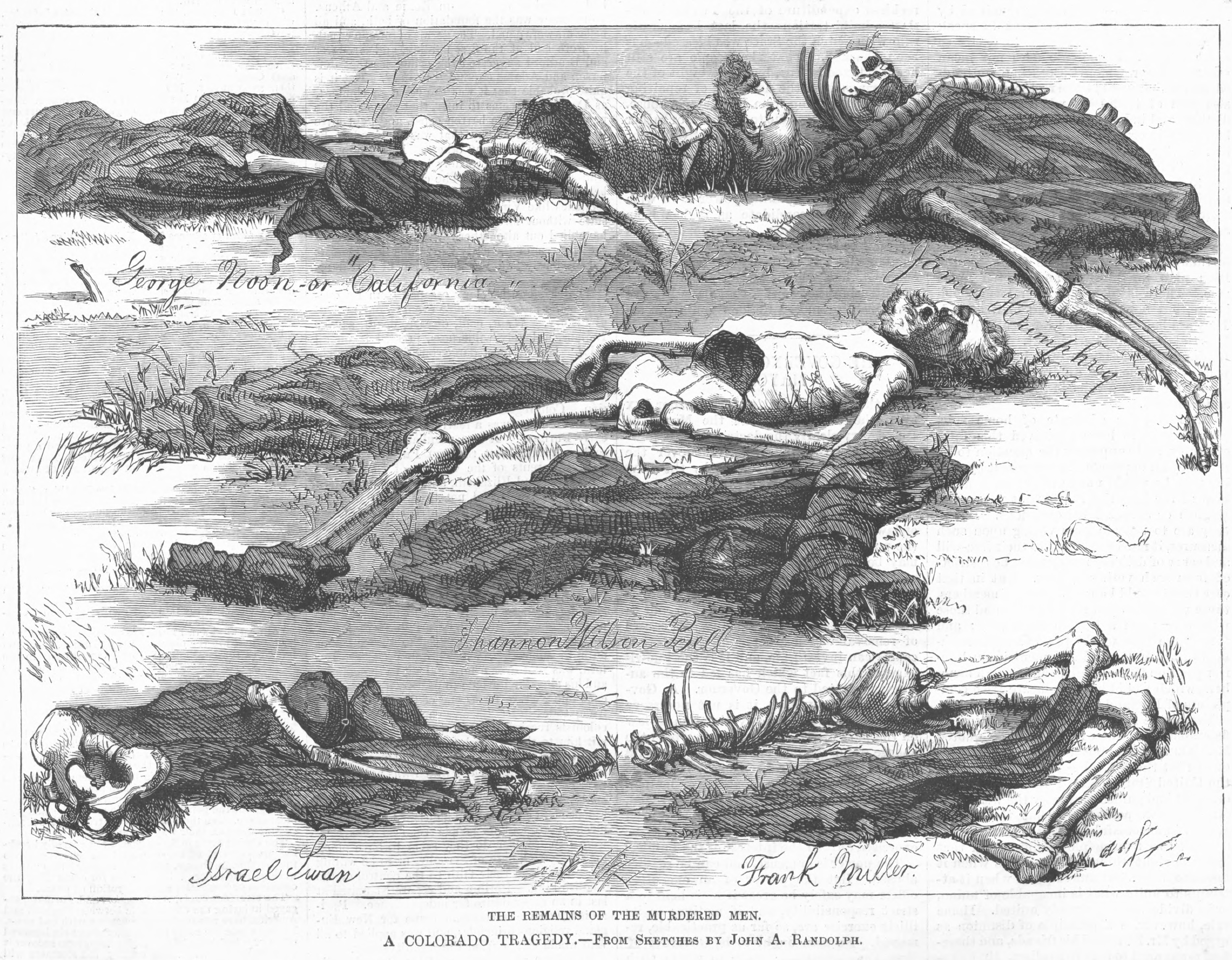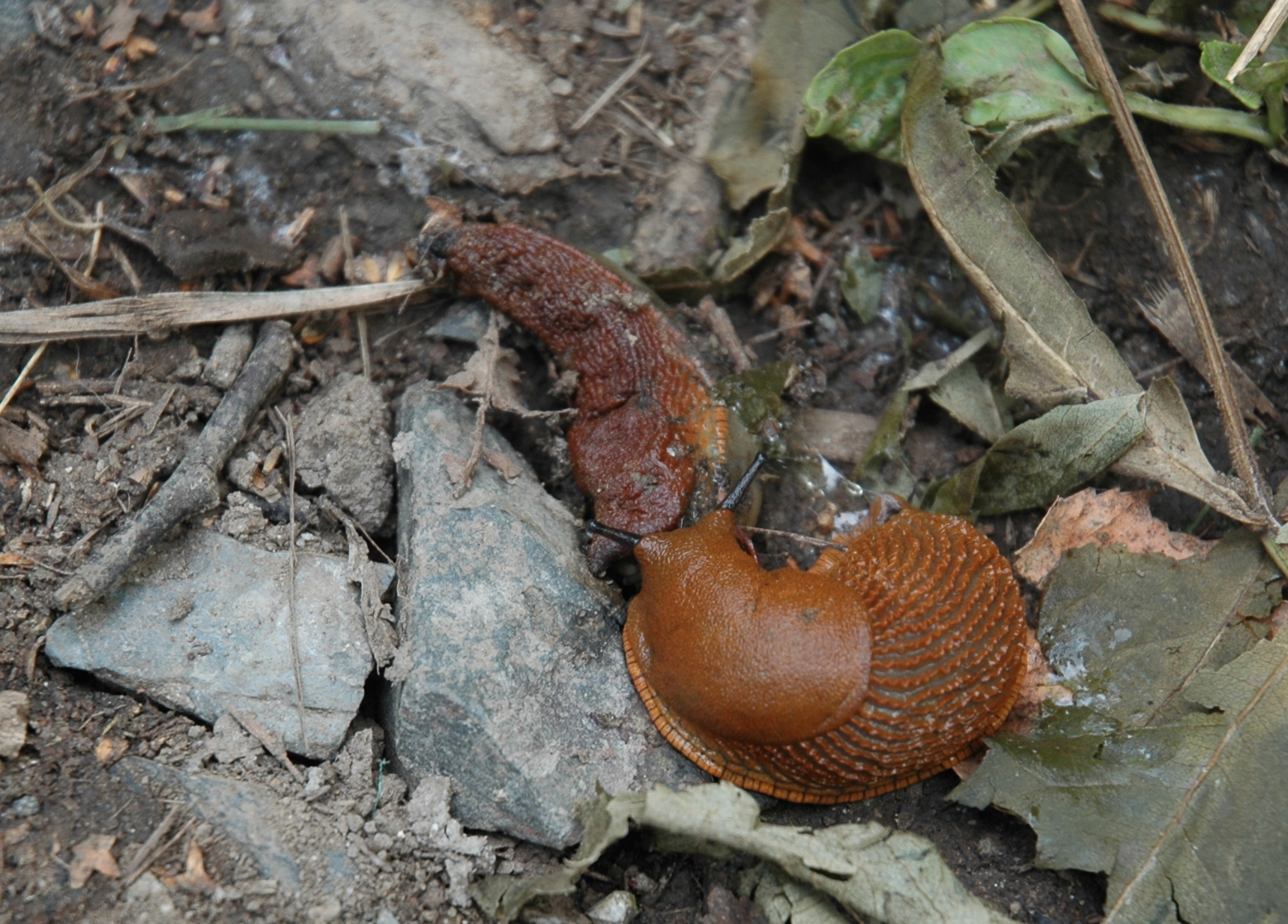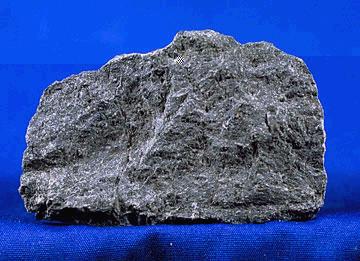|
Cannibal Plateau
Cannibal Plateau is a summit in Hinsdale County, Colorado in the United States. The broad mountain is located in the San Juan Mountains and within the Powderhorn Wilderness, a protected area managed by the Bureau of Land Management Gunnison Field Office and the Gunnison National Forest. Cannibal Plateau was named after an incident of cannibalism by Alferd Packer. The massacre site is near Lake City, southwest of the plateau. Geology Cannibal Plateau is composed of basaltic lava flows of the Hinsdale Formation, which are dated as 16 to 19 million years old. These lava flows are thought to be among the last volcanic events within the San Juan volcanic field and are therefore some of the best preserved. The Hinsdale Formation lava flows form an expansive alpine highland where the two highest ridges are Cannibal Plateau and nearby Calf Creek Plateau Calf Creek Plateau is a mountain in the northern San Juan Mountains of the Rocky Mountains of North America. The mountain ... [...More Info...] [...Related Items...] OR: [Wikipedia] [Google] [Baidu] |
San Juan Mountains
The San Juan Mountains is a high and rugged mountain range in the Rocky Mountains in southwestern Colorado and northwestern New Mexico. The area is highly mineralized (the Colorado Mineral Belt) and figured in the gold and silver mining industry of early Colorado. Major towns, all old mining camps, include Creede, Lake City, Silverton, Ouray, and Telluride. Large scale mining has ended in the region, although independent prospectors still work claims throughout the range. The last large scale mines were the Sunnyside Mine near Silverton, which operated until late in the 20th century and the Idarado Mine on Red Mountain Pass that closed down in the 1970s. Famous old San Juan mines include the Camp Bird and Smuggler Union mines, both located between Telluride and Ouray. The Summitville mine was the scene of a major environmental disaster in the 1990s when the liner of a cyanide-laced tailing pond began leaking heavily. Summitville is in the Summitville caldera, one of ... [...More Info...] [...Related Items...] OR: [Wikipedia] [Google] [Baidu] |
Alferd Packer
Alfred Griner Packer (January 21, 1842 – April 23, 1907), also known as "The Colorado Cannibal", was an American prospector and self-proclaimed professional wilderness guide who confessed to cannibalism during the winter of 1874. He and five other men had attempted to travel through the San Juan Mountains of Colorado, during the peak of a harsh winter. When only Packer reached civilization, he said that he had been abandoned by his party, but eventually confessed that the party had resorted to forced cannibalism of dead members to stay alive when they became lost. He later recanted this story, and confessed to having singularly lived off the flesh of his companions, during his snowbound state – after they had fallen victim to party member Shannon Bell, whom Packer said he shot in self-defense. He confessed to having used their flesh to survive, while stranded and during his trek out of the mountains, nearly two and a half months later. After Packer's story was called in ... [...More Info...] [...Related Items...] OR: [Wikipedia] [Google] [Baidu] |
Cannibal Plateau, Powderhorn Wilderness, Hinsdale County, Colorado, USA 03
Cannibalism is the act of consuming another individual of the same species as food. Cannibalism is a common ecological interaction in the animal kingdom and has been recorded in more than 1,500 species. Human cannibalism is well documented, both in ancient and in recent times. The rate of cannibalism increases in nutritionally poor environments as individuals turn to members of their own species as an additional food source.Elgar, M.A. & Crespi, B.J. (1992) ''Cannibalism: ecology and evolution among diverse taxa'', Oxford University Press, Oxford ngland New York. Cannibalism regulates population numbers, whereby resources such as food, shelter and territory become more readily available with the decrease of potential competition. Although it may benefit the individual, it has been shown that the presence of cannibalism decreases the expected survival rate of the whole population and increases the risk of consuming a relative. Other negative effects may include the increased ri ... [...More Info...] [...Related Items...] OR: [Wikipedia] [Google] [Baidu] |
Calf Creek Plateau
Calf Creek Plateau is a mountain in the northern San Juan Mountains of the Rocky Mountains of North America. The mountain is located in Hinsdale County, and at an elevation of , it is the high point of the Powderhorn Wilderness. Geology Calf Creek Plateau is within the San Juan volcanic field and volcanic rocks dominate the region. The mountain itself is composed of basaltic lava flows of the Hinsdale Formation, which are dated as 16 to 19 million years old. These lava flows are thought to be among the last volcanic events in the area and are some of the best preserved. The Hinsdale Formation lava flows form an expansive alpine highland where the two highest ridges are Calf Creek Plateau and nearby Cannibal Plateau. Calf Creek Plateau was glaciated, and the most prominent glacial cirque A (; from the Latin word ') is an amphitheatre-like valley formed by glacial erosion. Alternative names for this landform are corrie (from Scottish Gaelic , meaning a pot or cauldron) ... [...More Info...] [...Related Items...] OR: [Wikipedia] [Google] [Baidu] |
San Juan Volcanic Field
The San Juan volcanic field is part of the San Juan Mountains in southwestern Colorado. It consists mainly of volcanic rocks that form the largest remnant of a major composite volcanic field that covered most of the southern Rocky Mountains in the Middle Tertiary geologic time.Steven, Thomas A.; Lipman, Peter W. (1976)"Calderas of the San Juan Volcanic Field, Southwestern Colorado" ''U.S. Geological Survey Professional Papers''. Washington, DC: U.S. Government Printing Office. 958: 1–35. Retrieved 2012-05-16. There are approximately fifteen calderas known in the San Juan Volcanic Fields; however, it is possible that there are two or even three more in the region. The region began with many composite volcanoes that became active between 35 and 40 million years ago, with peak activity in the time period around 35-30 million years ago. Around this time the activity began to include explosive ash-flow eruptions. Many of these volcanoes experienced caldera collapse, resulting in th ... [...More Info...] [...Related Items...] OR: [Wikipedia] [Google] [Baidu] |
Hinsdale Formation
The Hinsdale Formation is a geologic formation exposed in southwestern Colorado and northern New Mexico. It has a radiometric age of 4.4 to 26.8 million years, corresponding to the Neogene period. Description The Hinsdale Formation is a bimodal volcanic formation, containing silica-poor olivine basalt and high-silica rhyolite with only small quantities of volcanic rock of intermediate composition. The sequence reflects assimilation and fractional crystallization (AFC) of a primitive basalt magma. Total thickness is in excess of . The formation is the youngest volcanic formation of the San Juan volcanic field, and is separated from older units by a significant erosional surface. Radiometric ages range from 4.4 to 26.8 million years. The formation once formed an extensive thin veneer over the San Juan volcanic field before itself being eroded. The change to bimodal association coincided with the transition from Laramide compression to Rio Grande rift extension, a pattern seen ... [...More Info...] [...Related Items...] OR: [Wikipedia] [Google] [Baidu] |
Mafic
A mafic mineral or rock is a silicate mineral or igneous rock rich in magnesium and iron. Most mafic minerals are dark in color, and common rock-forming mafic minerals include olivine, pyroxene, amphibole, and biotite. Common mafic rocks include basalt, diabase and gabbro. Mafic rocks often also contain calcium-rich varieties of plagioclase feldspar. Mafic materials can also be described as ferromagnesian. History The term ''mafic'' is a portmanteau of "magnesium" and "ferric" and was coined by Charles Whitman Cross, Joseph P. Iddings, Louis Valentine Pirsson, and Henry Stephens Washington in 1912. Cross' group had previously divided the major rock-forming minerals found in igneous rocks into ''salic'' minerals, such as quartz, feldspars, or feldspathoids, and ''femic'' minerals, such as olivine and pyroxene. However, micas and aluminium-rich amphiboles were excluded, while some calcium minerals containing little iron or magnesium, such as wollastonite or apatite, were incl ... [...More Info...] [...Related Items...] OR: [Wikipedia] [Google] [Baidu] |
Lake City, Colorado
Lake City is a Statutory Town that is the county seat, the most populous community, and the only incorporated municipality in Hinsdale County, Colorado, United States. It is located in the San Juan Mountains in a valley formed by the convergence of Henson Creek and the headwaters of the Lake Fork of the Gunnison River about seven miles (11 km) east of Uncompahgre Peak, a Colorado fourteener. Lake City is named after nearby Lake San Cristobal. This area lies at the southern end of the Colorado Mineral Belt and when rich mineral deposits were discovered the native population was pushed from their tribal lands and the town of Lake City was incorporated in 1873. With the completion of the first road into the mountains in this region, Lake City served as a supply center for the many miners and prospectors flooding into the area. As a supply center, the town boomed to as many as 3,000 to 5,000 settlers. But as the first-discovered deposits were found to be only moderately prod ... [...More Info...] [...Related Items...] OR: [Wikipedia] [Google] [Baidu] |
Gunnison National Forest
The Gunnison National Forest is a U.S. National Forest covering 1,672,136 acres (2,612.71 sq mi, or 6,766.89 km²) - - September 30, 2007 in , Gunnison, Hinsdale and [...More Info...] [...Related Items...] OR: [Wikipedia] [Google] [Baidu] |
Hinsdale County, Colorado
Hinsdale County is a county located in the U.S. state of Colorado. As of the 2020 census, the population was 788, making it the second-least populous county in Colorado. With a population density of only , it is also the least-densely populated county in Colorado. The county seat and only incorporated municipality in the county is Lake City. The county is named for George A. Hinsdale, a prominent pioneer and former Lieut. Governor of Colorado Territory. Geography According to the U.S. Census Bureau, the county has a total area of , of which is land and (0.5%) is water. Hinsdale County is one of the most remote counties in Colorado and the United States. The county is covered by mountains, including multiple fourteeners, and contains one of the largest roadless areas in the country. The continental divide crosses the county twice. Most of the county is divided among several different national forests and the Weminuche Wilderness area. Adjacent counties * Gunnison – nort ... [...More Info...] [...Related Items...] OR: [Wikipedia] [Google] [Baidu] |
Bureau Of Land Management
The Bureau of Land Management (BLM) is an agency within the United States Department of the Interior responsible for administering federal lands. Headquartered in Washington DC, and with oversight over , it governs one eighth of the country's landmass. President Harry S. Truman created the BLM in 1946 by combining two existing agencies: the General Land Office and the Grazing Service. The agency manages the federal government's nearly of subsurface mineral estate located beneath federal, state and private lands severed from their surface rights by the Homestead Act of 1862. Most BLM public lands are located in these 12 western states: Alaska, Arizona, California, Colorado, Idaho, Montana, Nevada, New Mexico, Oregon, Utah, Washington and Wyoming. The mission of the BLM is "to sustain the health, diversity, and productivity of the public lands for the use and enjoyment of present and future generations." Originally BLM holdings were described as "land nobody w ... [...More Info...] [...Related Items...] OR: [Wikipedia] [Google] [Baidu] |
Protected Area
Protected areas or conservation areas are locations which receive protection because of their recognized natural, ecological or cultural values. There are several kinds of protected areas, which vary by level of protection depending on the enabling laws of each country or the regulations of the international organizations involved. Generally speaking though, protected areas are understood to be those in which human presence or at least the exploitation of natural resources (e.g. firewood, non-timber forest products, water, ...) is limited. The term "protected area" also includes marine protected areas, the boundaries of which will include some area of ocean, and transboundary protected areas that overlap multiple countries which remove the borders inside the area for conservation and economic purposes. There are over 161,000 protected areas in the world (as of October 2010) with more added daily, representing between 10 and 15 percent of the world's land surface area. As of ... [...More Info...] [...Related Items...] OR: [Wikipedia] [Google] [Baidu] |





